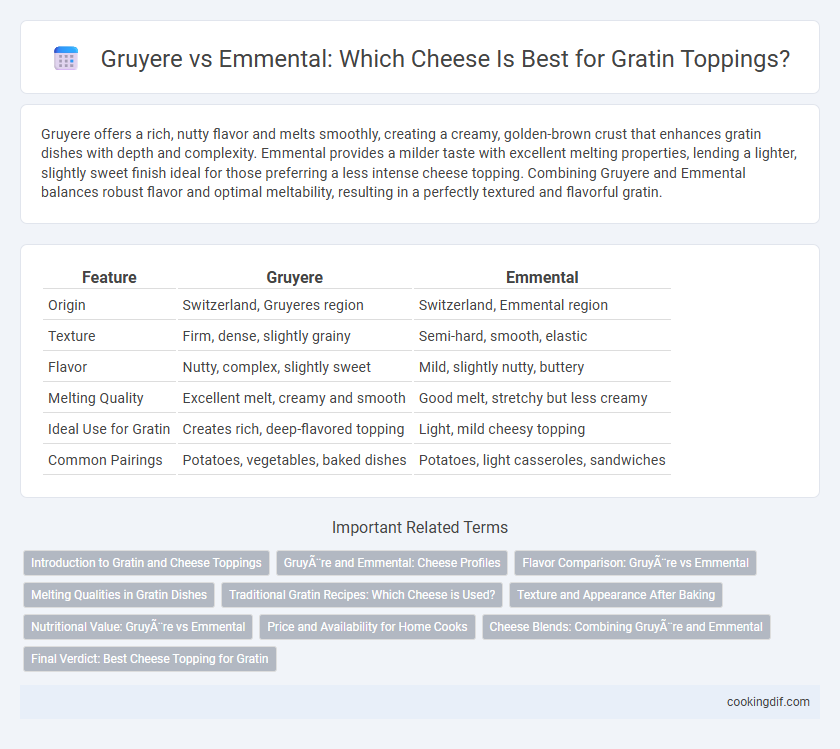Gruyere offers a rich, nutty flavor and melts smoothly, creating a creamy, golden-brown crust that enhances gratin dishes with depth and complexity. Emmental provides a milder taste with excellent melting properties, lending a lighter, slightly sweet finish ideal for those preferring a less intense cheese topping. Combining Gruyere and Emmental balances robust flavor and optimal meltability, resulting in a perfectly textured and flavorful gratin.
Table of Comparison
| Feature | Gruyere | Emmental |
|---|---|---|
| Origin | Switzerland, Gruyeres region | Switzerland, Emmental region |
| Texture | Firm, dense, slightly grainy | Semi-hard, smooth, elastic |
| Flavor | Nutty, complex, slightly sweet | Mild, slightly nutty, buttery |
| Melting Quality | Excellent melt, creamy and smooth | Good melt, stretchy but less creamy |
| Ideal Use for Gratin | Creates rich, deep-flavored topping | Light, mild cheesy topping |
| Common Pairings | Potatoes, vegetables, baked dishes | Potatoes, light casseroles, sandwiches |
Introduction to Gratin and Cheese Toppings
Gruyere and Emmental are two classic Swiss cheeses frequently used as toppings in gratin dishes, prized for their melting qualities and flavor profiles. Gruyere offers a rich, nutty taste and melts into a creamy, smooth texture, ideal for achieving a golden, bubbly crust. Emmental provides a milder, slightly sweet flavor and a stretchy consistency that enhances the gratin's gooey cheese layer without overpowering other ingredients.
Gruyère and Emmental: Cheese Profiles
Gruyere features a rich, nutty flavor with a creamy texture that melts smoothly, making it ideal for gratin dishes that require a deep, savory cheese topping. Emmental has a milder, slightly sweet taste with characteristic holes and a firmer texture, offering a less intense but equally meltable option for gratin. Combining Gruyere and Emmental balances boldness and creaminess, enhancing the overall flavor complexity and achieving a perfect golden crust.
Flavor Comparison: Gruyère vs Emmental
Gruyere offers a rich, nutty flavor with a slightly salty undertone that intensifies when melted, making it ideal for gratin toppings. Emmental provides a milder, buttery taste with subtle fruity notes, resulting in a creamier texture but less pronounced flavor. Choosing Gruyere enhances gratin complexity, while Emmental yields a smoother, more delicate finish.
Melting Qualities in Gratin Dishes
Gruyere cheese offers superior melting qualities in gratin dishes due to its smooth, creamy texture and balanced fat content, which creates a rich, bubbly crust. Emmental tends to melt more inconsistently, often producing oil separation and less cohesive browning, making it less ideal as a gratin topping. Choosing Gruyere enhances the gratin's golden, velvety surface and ensures even heat distribution for optimal texture and flavor.
Traditional Gratin Recipes: Which Cheese is Used?
Traditional gratin recipes predominantly feature Gruyere cheese for its rich, nutty flavor and excellent melting properties that create a creamy, golden crust. Emmental is occasionally used for its mild, slightly sweet taste and smooth texture, but it lacks the depth and sharpness that Gruyere provides. Classic dishes like Gratin Dauphinois often rely on Gruyere to achieve the authentic, savory finish that defines the dish.
Texture and Appearance After Baking
Gruyere develops a rich, golden-brown crust with a slightly oily sheen after baking, offering a creamy and smooth texture that melts evenly in gratins. Emmental creates a lighter, more elastic topping with characteristic holes and a mildly browned surface, contributing a stretchier, chewy texture. Both cheeses enhance gratin dishes but Gruyere emphasizes a velvety melt and deeper caramelization, while Emmental provides a springier bite with distinct visual appeal.
Nutritional Value: Gruyère vs Emmental
Gruyere cheese contains approximately 413 calories, 29 grams of fat, and 30 grams of protein per 100 grams, offering a rich source of calcium and vitamin A, which supports bone health. Emmental has around 380 calories, 28 grams of fat, and 28 grams of protein per 100 grams, with slightly lower calcium content but higher vitamin B12 levels important for nerve function. Both cheeses provide essential nutrients for a gratin topping, yet Gruyere's higher calcium and protein content make it a more nutrient-dense option.
Price and Availability for Home Cooks
Gruyere cheese offers a rich, nutty flavor ideal for gratin but typically comes at a higher price point and may be less readily available in regular grocery stores. Emmental, while milder in taste, is more affordable and widely accessible, making it a practical choice for home cooks seeking a budget-friendly option. Both cheeses melt well, but Emmental's easier availability and lower cost make it more convenient for everyday gratin preparations.
Cheese Blends: Combining Gruyère and Emmental
Gruyere and Emmental cheese blends create the perfect balance for gratin toppings, combining Gruyere's rich, nutty flavor with Emmental's mild, slightly sweet profile. This blend ensures a smooth melt and a golden, bubbling crust that enhances texture and taste. Using both cheeses optimizes flavor complexity and melting properties, elevating the gratin experience.
Final Verdict: Best Cheese Topping for Gratin
Gruyere stands out as the best cheese topping for gratin due to its rich, nutty flavor and excellent melting properties that create a creamy, golden crust. Emmental offers a milder taste with good melting ability but lacks the depth and complexity that Gruyere provides. For a perfectly gratinated dish with balanced texture and robust flavor, Gruyere is the optimal choice.
Gruyère vs Emmental for cheese topping Infographic

 cookingdif.com
cookingdif.com